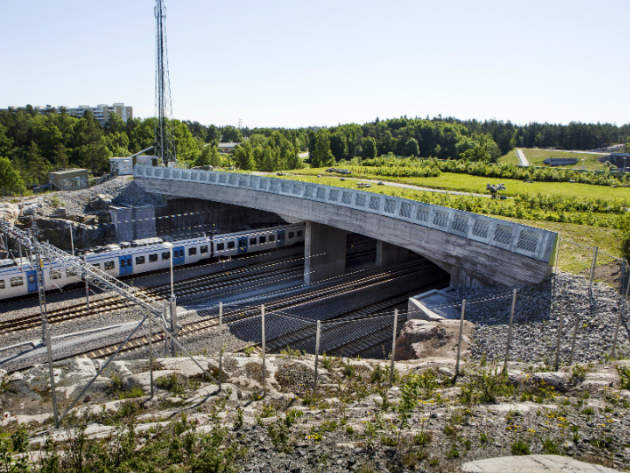
Rail infrastructure projects and wildlife preservation don’t always make for the easiest of bedfellows.
From continuing reports of elephants being killed on Indian railways to the potential impact of the proposed HS2 route in the UK, the peaceful co-existence of flora, fauna and track isn’t a given.

Discover B2B Marketing That Performs
Combine business intelligence and editorial excellence to reach engaged professionals across 36 leading media platforms.
Just take the latter example. The high-speed line, that could one day link London to Birmingham, Manchester and Leeds, has lit the touch paper with environmentalists. In the capital alone, 18 nature sites would be impacted by the line’s construction, argues London Wildlife Trust.
While that particular debate rages on, are there examples of rail projects incorporating green corridors into their stretches, as opposed to contributing to their destruction?
Two such projects have been initiated in the last six months, in Sweden and Kenya.
Kallhäll nature bridge, Stockholm
Opened in June, this 63m ‘landscape’ bridge provides a corridor for wildlife to safely pass over the tracks in Kallhäll, suburban Stockholm.

US Tariffs are shifting - will you react or anticipate?
Don’t let policy changes catch you off guard. Stay proactive with real-time data and expert analysis.
By GlobalDataConnecting a large residential area with Görväln Nature Reserve, the bridge is part of an investment by Trafikverket, the Swedish transport administration – which is in the process of extending the railway between Tomteboda and Kallhäll – from two to four tracks.
The project had initially been pencilled in for completion last year, but was delayed due to questions of land use.
The car-free bridge, which is 50m to 60m in width, also provides members of the public with easier access to the Görväln Nature Reserve. In the coming months, Trafikverket will set about festooning the pass with meadow plants, the government agency recently announced.
Stretching over 10km, Görväln is notable for its vast woodland.
Madaraka Express railway, Kenya
In May, Kenya inaugurated its first new major railway in more than a century, running from the country’s capital of Nairobi to Mombasa on the coast – a stretch of 293km.
Funded by Chinese backers to the tune of $3.2bn, the line is Kenya’s largest infrastructure project since gaining independence in 1963.
With a journey time of roughly four-and-half hours from Nairobi to Mombasa, the railway passes through some of the East African nation’s most notable national parks and reserves.
This includes Tsavo National Park, considered to be one of the world’s greatest bastions of biodiversity, and home to the Masai lion, black rhino, cape buffalo, elephants and leopards.
Having taken over three years to build, the railway has been constructed with the local environment in mind. Each of its 32 stations boast aesthetics to reflect the surrounding ecosystem; Athi River station, situated just outside Nairobi, was designed to reflect its surrounding hills, while Miasenyi station carries a zebra motif.
Still, the project has not entirely avoided unfavourable scrutiny from wildlife groups. Despite designers creating designated wildlife corridors, and raising sections of the track to allow for animal movement, at least ten elephants were killed by trains during construction, claims NGO Save the Elephants.
And looking ahead, HS2, West Midlands section?
While the to-ing and fro-ing continues, developers are reported to be on the verge of starting work on creating new wildlife habitats in the West Midlands, which they say will cancel out any harmful impact on local nature as a result of the line.
The starting project is the creation of a new wood around Finham Brook in Kenilworth, Warwickshire. Expected to be completed by the end of the year, it will feature more than 6,000 trees and shrubs, says HS2, as well as birds and great crested newts.
“The new habitats at Finham Brook will be the first of many to come between London and the West Midlands,” said Anthony Coumbe HS2’s head of environment for the region, speaking in August.
“They will help us to care for the local environment and serve as a new home to wildlife affected by the future development of the railway.
“At Finham Brook, we’re creating a bigger and better habitat than local species such as great crested newts currently have. We’ll relocate newts to the habitat next year, once it has become properly established, while other wildlife will start to use the area naturally over time.
“Ultimately, we’re aiming to create a railway that works for nature as well as passengers, with a green corridor of connected habitats running through the spine of the country.”
But, unsurprisingly, local wildlife trusts are unconvinced by the plan.
“There’s also a question to ask of the sourcing of the seven million trees to be planted, given the on-going issues around the import of tree pests and diseases,” said Ian Jelley, living landscapes director at the Wildlife Trust.
“You cannot create a ‘railway that works for wildlife’ when destroying irreplaceable ancient woodland along the route.”





